Perhaps this whole idea to revisit Paris was inspired by a French song which I heard on the radio some time ago. A beautiful song. I completely turned to mush when listening to it. Although I did not understand any of the lyrics, the melody and the singing were so convincing that I quite clearly felt the passion that oozed from each note and I fell utterly in love with the voices. After a while I heard it again. And again. And all of that was happening over a period of a couple of years. At the beginning of 2016, I heard the song again, but this time I was not lazy and started to research as to see what it was. The song is for three voices and these are three male voices. I could not discern the lyrics, but I heard something like “elle,” which means “she” and that did not help at all. Then I found the telephone number of the radio station, called them, told them I had heard a song I liked in the past hour and they promised to send me a list of songs they had played in that period, which they did (this was the “Nostalgija” radio station and they deserve to be praised). Thus I learned that this was a song from the musical “Notre-Dame de Paris” made after the book by Victor Hugo “The Hunchback of Notre-Dame.” The next step, of course, was to read the book dedicated in fact to Paris, the 15th-century Paris to be exact, and when you finally go through the part of the book describing the city of the time, a romantic soul like me can give in to the harsh, tragic and yet sometimes unusually sublime destinies. Although I knew the novel could not have a happy ending, as the events from the book unfolded and went towards their peak, everything seemed to accelerate and turn into a vortex which also sucked me in and emotionally shook me to my core, so that even today I still keep wondering with a heavy sigh: “Why?!” Or perhaps it was the song to blame for this deep experience of the book. I recommend them both.
Before this visit to Paris, the main image that spontaneously kept appearing in my head was that I look at the church of Notre Dame from the left bank of the Seine while the sun is shining. I couldn’t believe my luck when that indeed happened as I walked along the quays of the Seine one day, but before that I went for a walk on a cloudy day around the Seine islands. There are two of them – the Ile de la Cite and the Ile Saint Louis. These islands are the true epicentre of Paris and this is the place from which the city started to develop between 250 and 200 BC when a fishing tribe founded their settlement there.
The Paris cathedral and that is the Notre Dame or the Church of Our Lady is situated at the Ile de la Cite and it was the first place I visited that day. Its construction started in the second half of the 12 century and lasted until mid-14th century, and it belongs to the early gothic style.
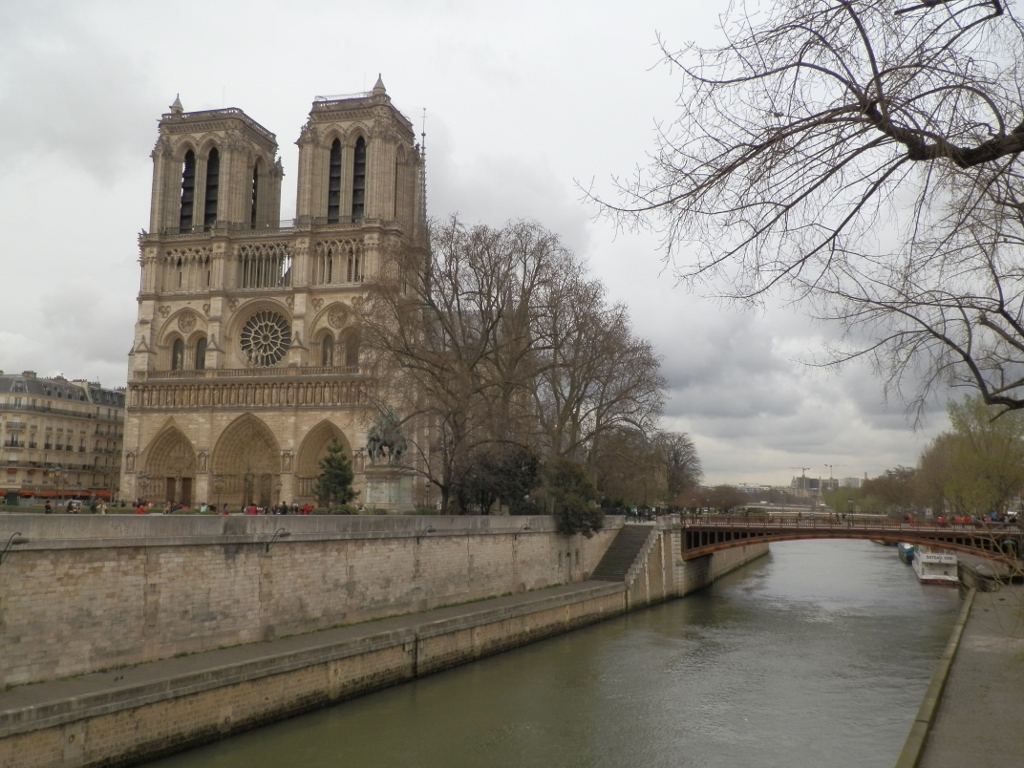 View at the Ile de la Cite and the Notre Dame Cathedral
View at the Ile de la Cite and the Notre Dame Cathedral
The facade of the Notre Dame is one of the most recognizable and it seems to me that its portals, the rosette and towers are depicted in more detail than in the case of any other church.
As far as portals are concerned, the central one is bigger and higher than the side ones and they all show scenes from the Bible – the left one is dedicated to the Virgin, the right one to St. Anne and the middle one shows scenes from the Last Judgment.
Above the portals there is the Kings’ Gallery. There are 28 statues of the kings of Judea, the predecessors of Jesus. During the Commune, some people thought these were the kings of France and smashed them all to pieces, but they were restored later.
The rosette or the rose window of the church of Notre Dame in Paris is famous and it later served as a model for a large number of other churches and here, when looked from the outside, it stands behind the statues of the Virgin and Jesus, thus providing a large halo for them.
The Great Gallery, with numerous delicate arches links the two towers creating in this manner an additional play of horizontal and vertical lines, while the towers stand at the height of 69 metres. It is possible to climb the towers from where there are nice views at the surroundings.
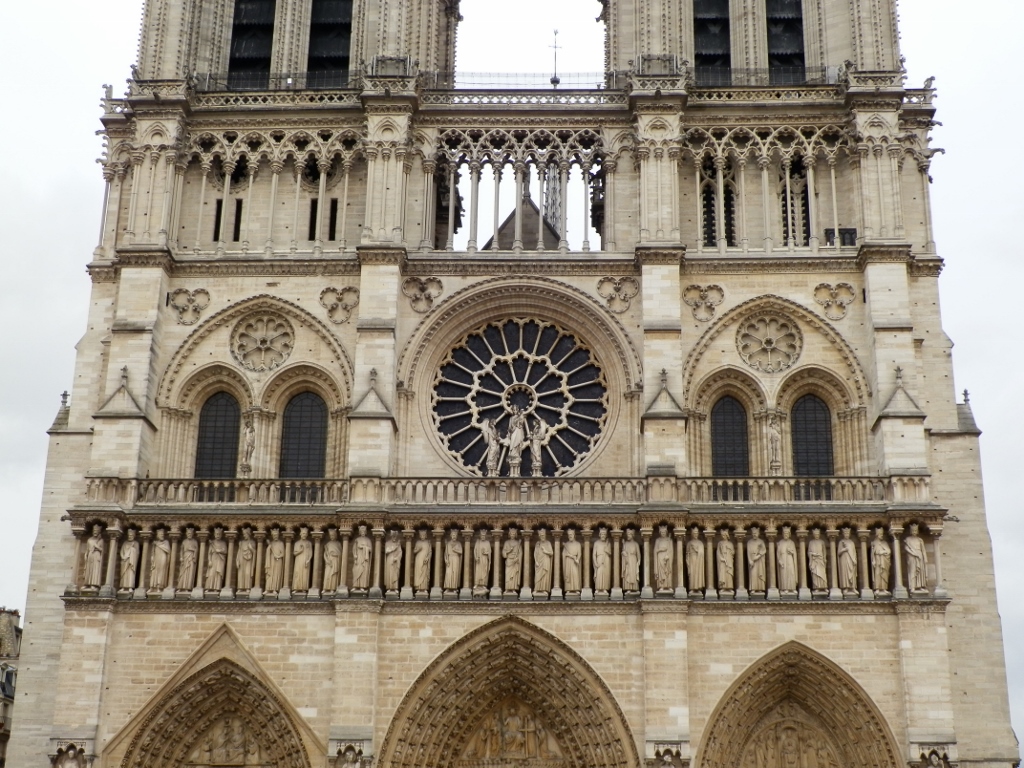 The front of the church of Notre Dame in Paris, the portals’ arches, King’s Gallery, Rosette, Great Gallery and the toweres
The front of the church of Notre Dame in Paris, the portals’ arches, King’s Gallery, Rosette, Great Gallery and the toweres
The interior of the cathedral is impressive and like most of the gothic churches there is a large number of stained glass windows, with the rosettes in the transept being particularly famous. The one on the north side has practically remained intact since the 13th century.
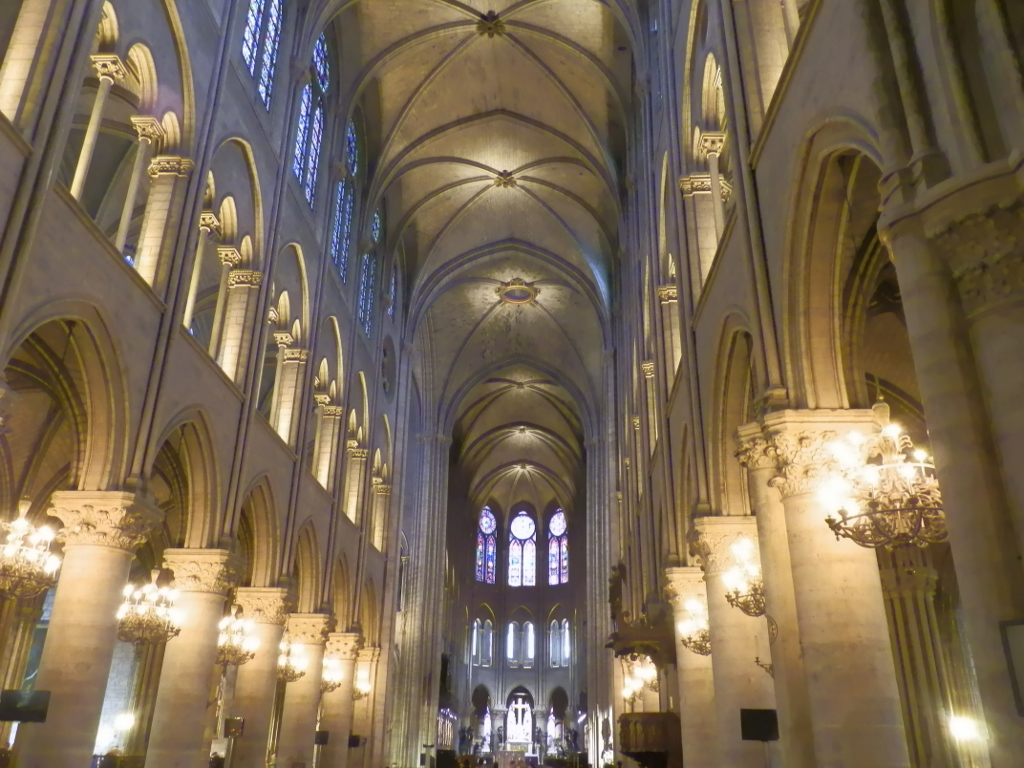 Interior of the church of Notre Dame in Paris
Interior of the church of Notre Dame in Paris
One of the specificities of the Notre Dame is a large number of chapels built along the wall of the cathedral and encircling the central nave. One of the reasons for that is that the existence of the chapels helped during the building of the cathedral on account of the large number of pillars that separated the chapels which then through flying buttresses carried the construction. However, another, very important, reason was that there was a large number of donors, either individual rich men or guilds, so I guess the main donors could get their own “private” chapel this way.
The chancel part is decorated from the outside with a belt-like procession of deep reliefs, in colour and with gold details, that show scenes from the Bible. This was intended for those who didn’t know how to read, so that they could visually be reminded of the details from the Scriptures.
After leaving the church I went to a small park that is at the very top of the Ile de la Cite and from which there is a fine view either towards the back of the Notre Dame or to the other island of Saint Louis.
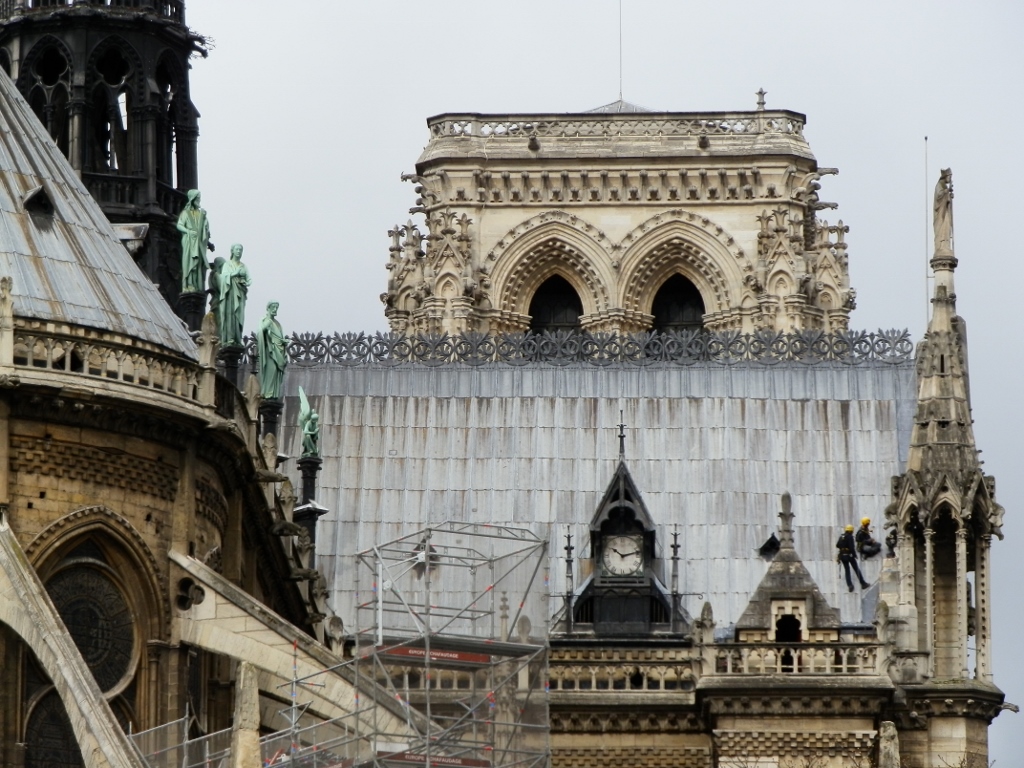 A detail of the church of Notre Dame in Paris; notice the workers on the right-hand side of the roof
A detail of the church of Notre Dame in Paris; notice the workers on the right-hand side of the roof
Then I moved to the other island and I made a fine circle there, but I also had a coffee in order to wake up a little, considering that the skies were quite dark. As some point it even started to rain quite a lot, so I moved into a church which I planned to visit anyway. The rain soon stopped and I continued with my walking tour of the islet of Saint Louis which is a very quiet place with a large number of buildings from the 17th century.
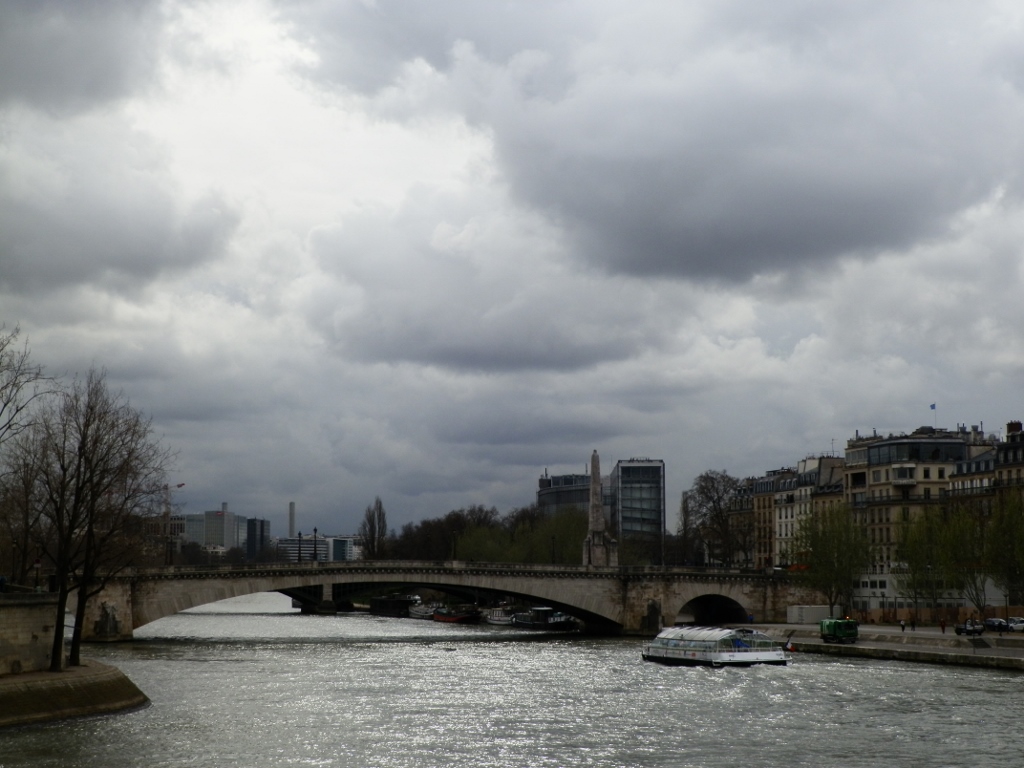 The cloudy sky above Paris
The cloudy sky above Paris
And so I returned to the Ile de la Cite and there I first walked around some side streets occasionally rendering interesting views of the cathedral and then I went back to the Place du Parvis, the plateau in front of the Notre Dame.
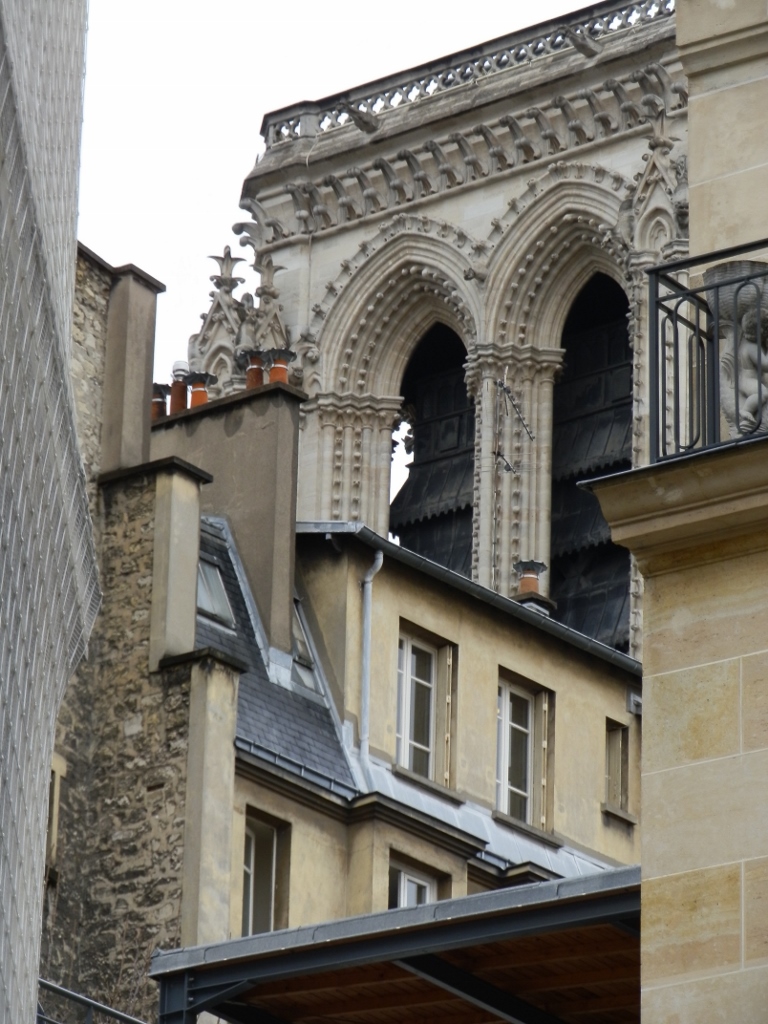 Ile de la Cite, a portion of the upper part of a tower of the Notre Dame
Ile de la Cite, a portion of the upper part of a tower of the Notre Dame
As I stood there and admired the beautiful building for a short while, the beautiful song dedicated to the unfortunate Esmeralda and its very beginning sang by Quasimodo resonated in my head.
After the music intermezzo, I headed towards a chapel that I had wanted to see even before, but somehow I had never managed to find the way to it. Before getting there, I passed by an exit from an underground station that is beside the Flower Market.
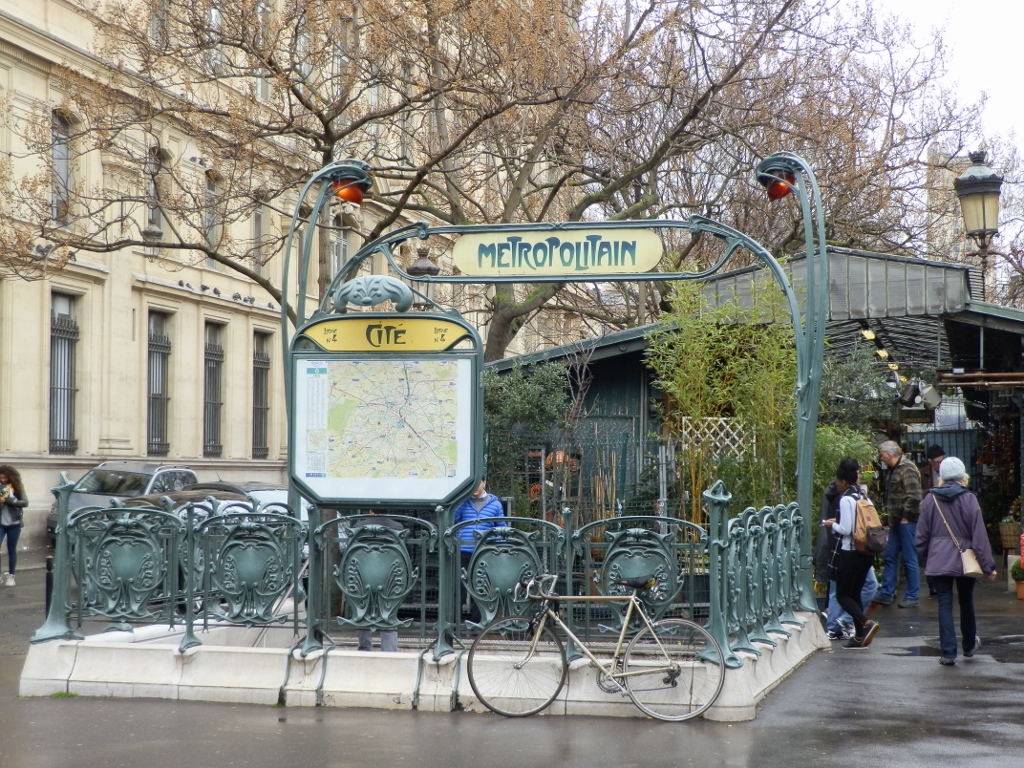 Ile de la Cite, an entrance/exit to/from the Cite metro station
Ile de la Cite, an entrance/exit to/from the Cite metro station
Right from that plateau where the underground station is, it is possible to see the Palace of Justice that used to be King’s Palace and during the reign of St. Louis the little church I’m talking about was built in one of the inner courts of the present-day Palace of Justice. This church is the Sainte-Chapelle or the Saint Chapel.
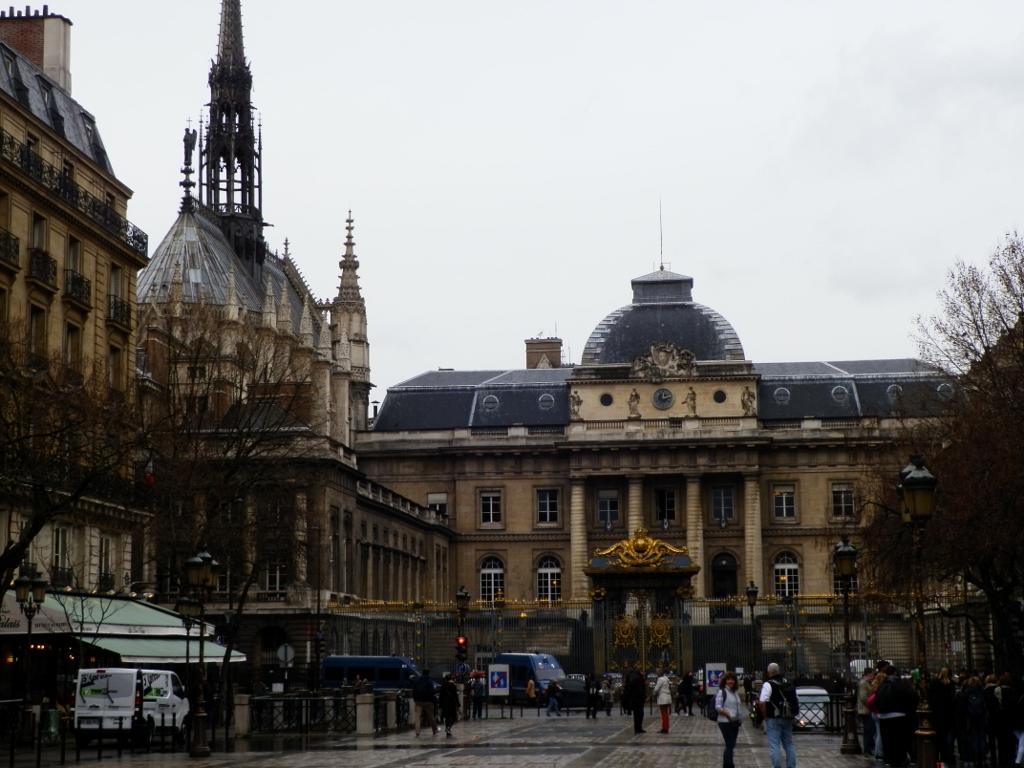 Ile de la Cite, the main entrance into the Palace of Justice is straight, with the Sainte-Chapelle to the left
Ile de la Cite, the main entrance into the Palace of Justice is straight, with the Sainte-Chapelle to the left
Even if you don’t see anything else in Paris, this is something you must not miss. I simply LOVED it! Still, to get there I had to stand in line for two hours. Literally. In order to reach the chapel, it is necessary to wait at one of the side entrances into the Palace of Justice which also serves for people who go there, I guess, for different trials judging by the piles of papers and documents many of them carried in their arms. The entrance into the building is the same, but once you’ve passed this gate there are immediately two other entrances leading to different sides. Still, in both cases, controls are very strict so that it all goes very slowly. In front of the building itself, there is even an attempt to make two separated, parallel lines, one for the Sainte-Chapelle, the other for the Palace of Justice, but there was in fact such an enormous crowd that at times I was not sure at all if I was at the right place, whether it all made any sense and whether I should wait at all. Eventually, I did decide to stand there and wait, whatever the outcome. Once I passed the control, I got to this inner court where the chapel is, bought a ticket there and entered.
The Sainte-Chapelle is a two-storey single nave church consecrated in 1248. It consists of two chapels, one on top of the other, with the lower one intended for court servants and being 7 metres high. To the left and right from the entrance, there are spiral staircases leading to the upper chapel and the upper chapel is a fantastic miracle. It was the first building ever that created in impression of not having any walls at all! Namely, the roof rests on slender pillars and supporting buttresses, while between the pillars there are only stained glass windows that are almost 15 metres high. These are the oldest stained glass windows in Paris and they originate from the 13th century. Everything is so well done that there have been no cracks for almost eight centuries. I visited the Sainte-Chapelle when it was cloudy, although the clouds had started to thin out a little, and still the impression was magical. I can only imagine how incredibly spectacular it must appear when the sun is shining.
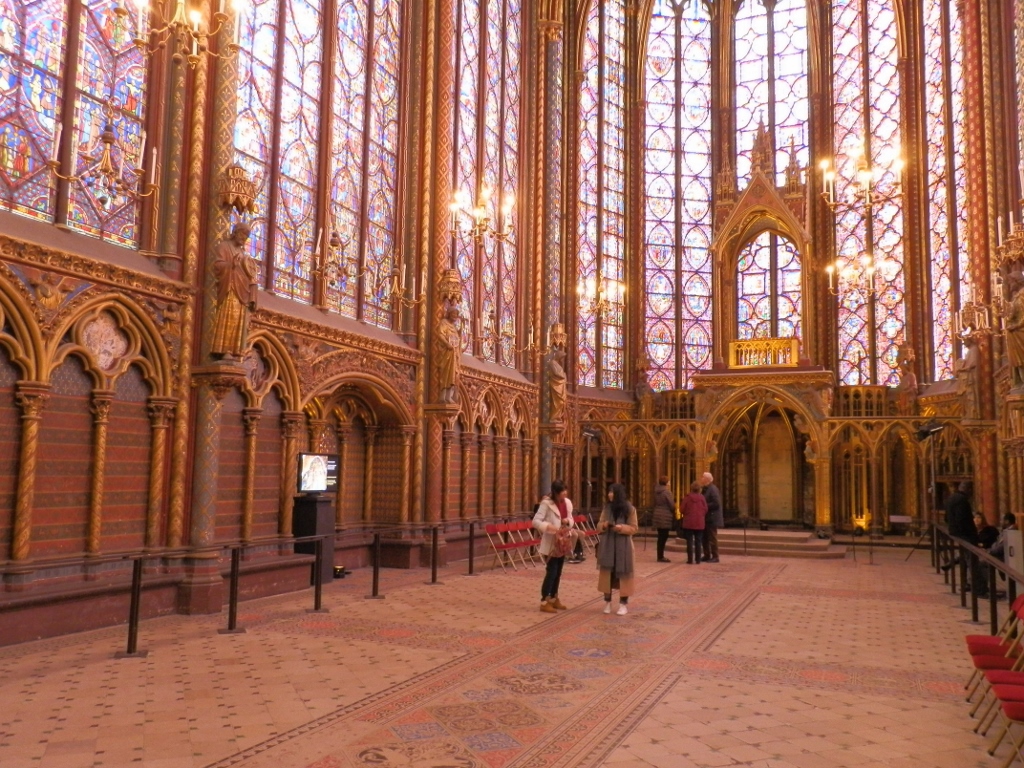 The Sainte-Chapelle
The Sainte-Chapelle
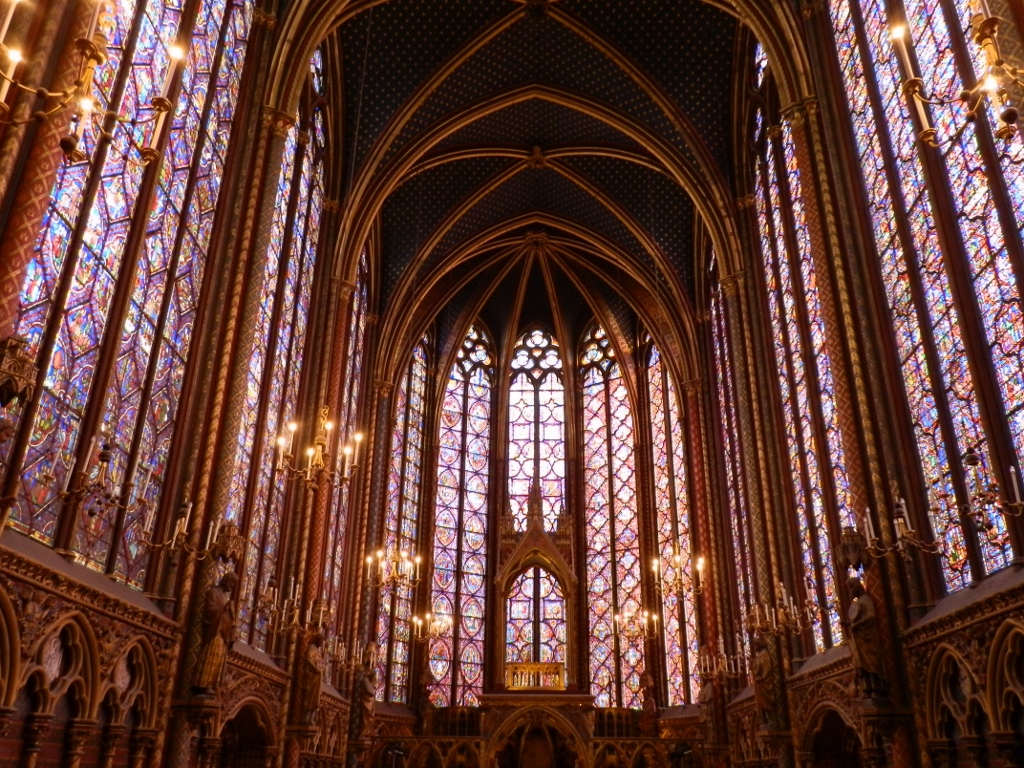 The Sainte-Chapelle
The Sainte-Chapelle
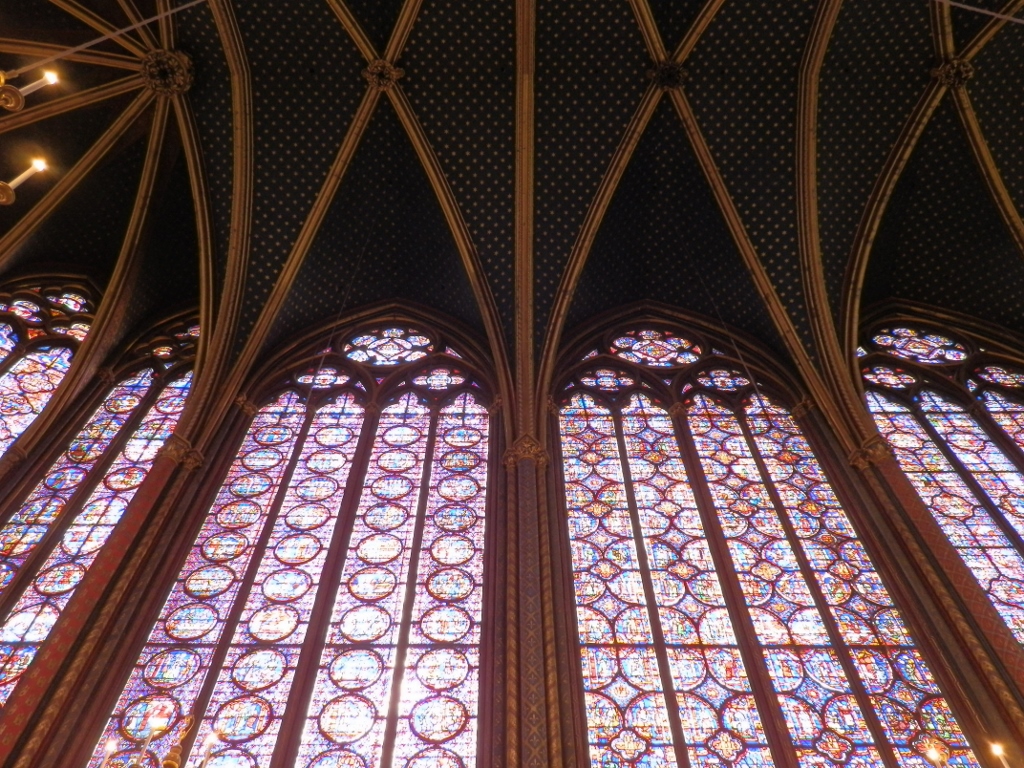 The Sainte-Chapelle
The Sainte-Chapelle
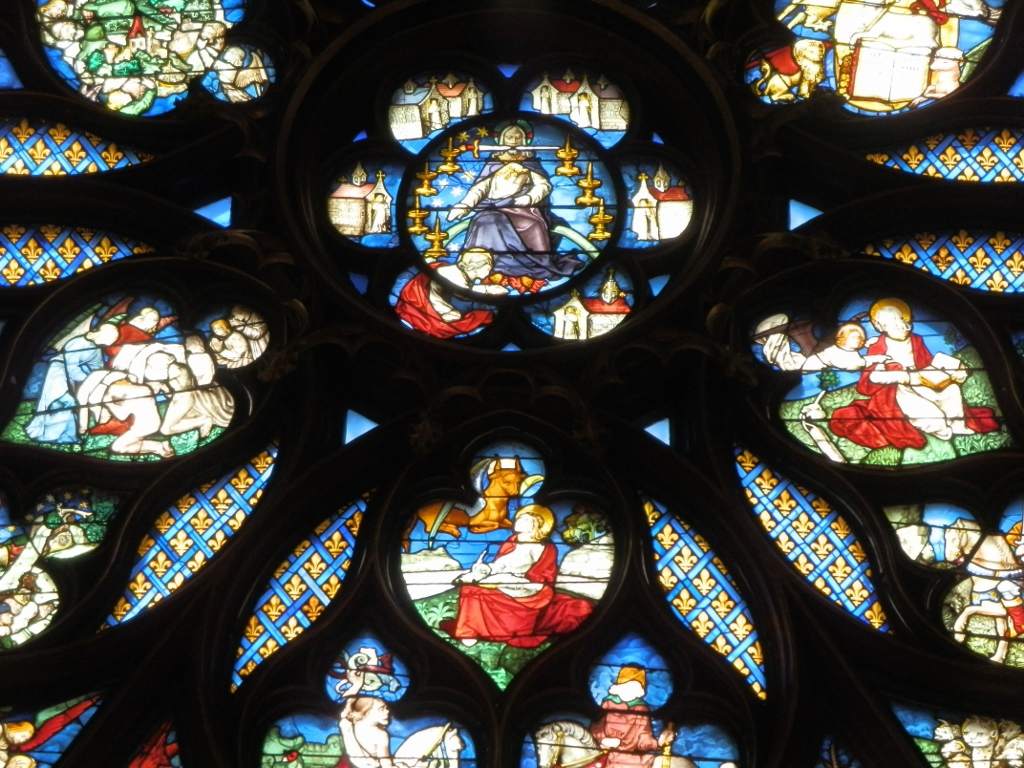 The Sainte-Chapelle, a detail from the Rosette
The Sainte-Chapelle, a detail from the Rosette
Still, the waiting in the line was not in vain, I think. I got an impression that it would be better if one bought a collective ticket, both for a visit to the Conciergerie, which is to the right from the main entrance into the Palace of Justice, and for a visit to the Sainte-Chapelle (entrance for the chapel is to the left from the main entrance). The price is slightly higher, but I think that those who have already been to see the gothic halls built by Philip the Fair have the right to skip the line when entering the Sainte-Chapelle. I haven’t verified this personally, it may be an erroneous assessment, but if you go to Paris and want to see the Sainte-Chapelle, I think this would be worth looking into, as it would save a minimum of two hours standing practically in one spot.
Full of impressions after my visit to the Sainte-Chapelle I continued to walk around the Ile de la Cite and thus I came to the Pont Neuf, the oldest bridge in Paris consisting of two segments, as it connects the two banks of the Seine while leading across the island. It was built at the end of the 16th century. At an extension of the bridge which lies on the island, there is a bronze statue of Henri IV on a horse and there is a whole story about the statue, but today this place or rather the metal fence around the plateau has become much more popular because of the tacky custom of hanging padlock of, I guess, those madly in love. I’m sure that at least a half of them have already broken up or got divorced in the meantime, but the padlocks are still standing there as a reminder of their “eternal” love. Well, I am probably too cynical, but this is what I thought of first when I saw this “custom.”
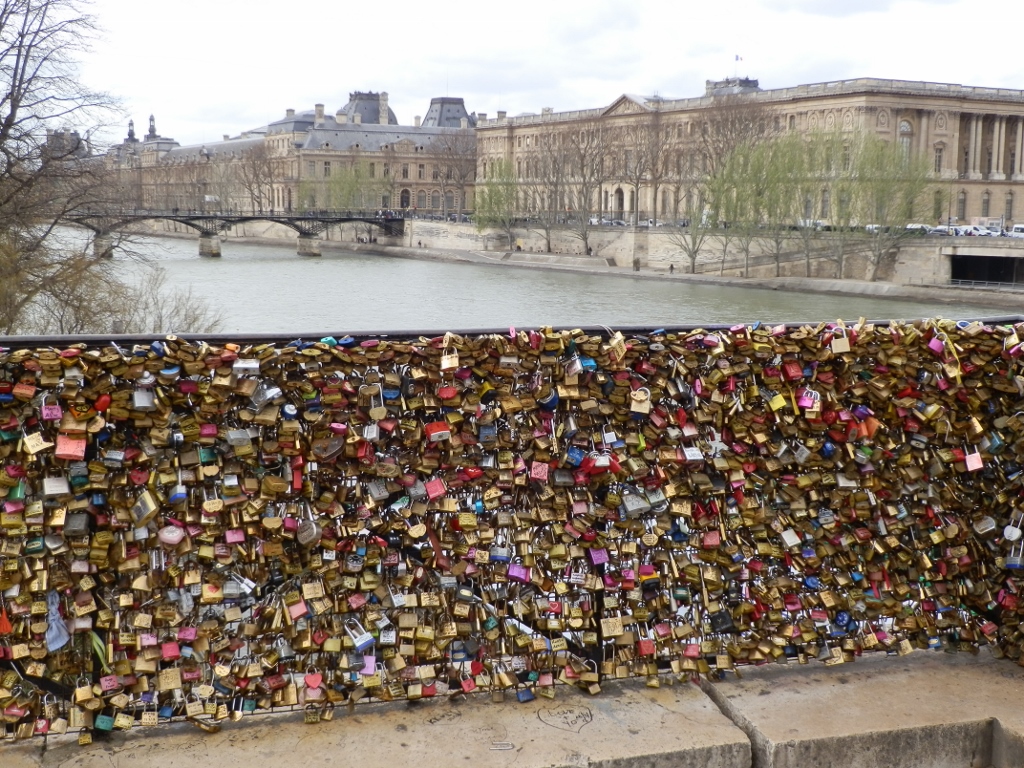 Fence at the Pont Neuf and the view at the Seine and the Louvre
Fence at the Pont Neuf and the view at the Seine and the Louvre
Crossing the Pont Neuf towards the left bank of the Seine, I enjoyed the nice views that spread in all the directions around me and one of them included watching a bateau-mouche that slowly glided from under the bridge. Regardless of the clouds and the relatively cold weather, it is always nice to admire Paris from these open tourist boats.
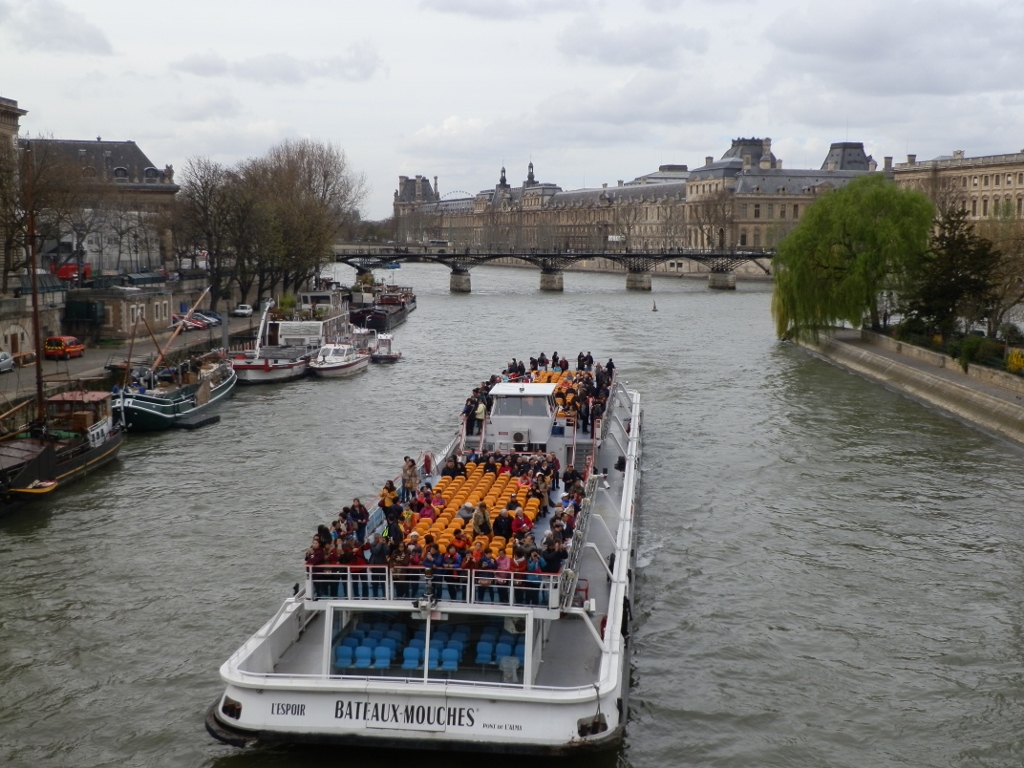 A bateau-mouche on the Seine
A bateau-mouche on the Seine
And thus I finished with my walking around the centre for the day, but before going back to my room to have a rest, I stopped at a famous pastry shop in order to try their version of Saint-Honore cake. This is a cake dedicated to the patron saint of pastry chefs. I’ve made the cake once myself, so I wanted to make a comparison. Their version was made, needless to say, much more skilfully, but I was proud to see that by taste my version was not lagging behind at all. Not a single bit(e).
After a brief respite at the flat, I headed to the famous Pere-Lachaise cemetery. This is the final resting place of Chopin, Oscar Wilde, Modigliani and Edit Piaf, among others. And although I have never been too great a fan of the Doors, I couldn’t come here without visiting the grave of Jim Morrison. I have to say that I was quite surprised to see that the grave had sunk in quite a lot. It may be seen that there are still fans who leave flowers and candles, but the grave still appears left to its destiny.
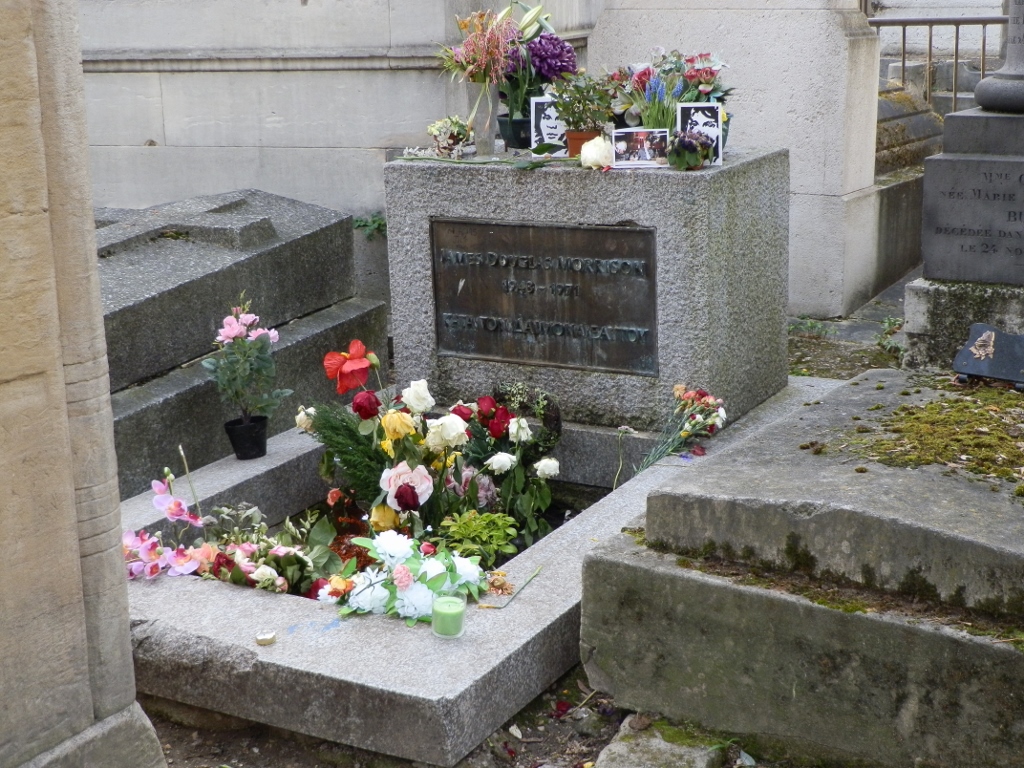 Jim Morrison’s grave
Jim Morrison’s grave
And finally came the time to have some fun. First I went to meet with Natasha and then the two of us went to some salon where there was a sale of designer’s clothes for those with passes. Natasha, of course, had the pass and then I spent some time looking at different dresses, tops, etc. There were nice pieces and somebody else would have had a blast, but I’m not too keen on shopping, so everything was just “fine” for me. Then we walked a little around the neighbourhood where Natasha used to work for a while many years ago and then we finally sat down for a drink. I ordered a panache, my favourite drink during this stay in Paris – a mixture of light bear and a soft lemonade, and it was a nice, refreshing end of a strenuous, but successful day.